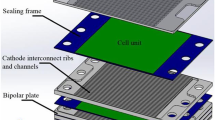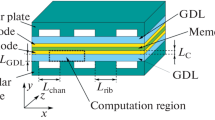Abstract
As a result of its advantages in the mid-temperature range, the proton ceramic fuel cell (PCFC) has gotten much attention compared to other fuel cells. In PCFC, whereby the vapor is generated at the cathode side, a flow field with high efficiency in water removal should be in its repertoire. A new inter-parallel flow field was designed and compared to the traditional flow fields: the serpentine, the parallel, and interdigitated flow fields to check its capacity to be a potential flow field for PCFC. The one-cell stack 3D model with the inter-parallel flow field was simulated to analyze the working details within the stack. The design harnessed the advantages of its three unique flow paths in solving the balance problem of pressure drop and effective oxygen transport and water removal. Results show that the design is a potential flow field for the cathode side of the PCFC.












Similar content being viewed by others
References
Shim JH (2018) Ceramics breakthrough. Nat Energy 3(3):168–169
Ding K, Zhu M, Han Z, Kochetov V, Lu L, Chen D (2020) Momentum-species-heat-electrochemistry distribution characteristics within solid oxide fuel cell stack with complex inter-digital fuel channels. Ionics 26(9):4567–4578
Chen D, Zou Y, Shi W, Serbin S, You H (2021) Proton exchange membrane fuel cells using new cathode field designs of multi-inlet shunt intake design. Int J Energy Res n/a, (n/a).
Dai JQ, Yang ZM, Wang WS, Liu JP, Akenteng YD, Chen DF (2022) Study the flow and species distribution characteristics in a typical 25-cell proton ceramic fuel cell stack by 3D large-scale modeling. Ionics
Chen H, Wang F, Wang W, Chen D, Li S-D, Shao Z (2016) H2S poisoning effect and ways to improve sulfur tolerance of nickel cermet anodes operating on carbonaceous fuels. Appl Energy 179:765–777
Kim J, Sengodan S, Kim S, Kwon O, Bu Y, Kim G (2019) Proton conducting oxides: a review of materials and applications for renewable energy conversion and storage. Renew Sustain Energy Rev 109:606–618
Chen D, Zhang Q, Lu L, Periasamy V, Tade MO, Shao Z (2016) Multi scale and physics models for intermediate and low temperatures H+-solid oxide fuel cells with H+/e(-)/O2- mixed conducting properties: Part A, generalized percolation theory for LSCF-SDC-BZCY 3-component cathodes. J Power Sources 303:305–316
Blum L, de Haart LGJ, Malzbender J, Menzler NH, Remmel J, Steinberger-Wilckens R (2013) Recent results in Jülich solid oxide fuel cell technology development. J Power Sources 241:477–485
Chen D, Xu Y, Tade MO, Shao Z (2017) General Regulation of Air Flow Distribution characteristics within planar solid oxide fuel cell stacks. ACS Energy Lett 2:319–326
Chen D, Xu Y, Hu B, Yan C, Lu L (2018) Investigation of proper external air flow path for tubular fuel cell stacks with an anode support feature. Energy Convers Manage 171:807–814
Boddu R, Marupakula UK, Summers B, Majumdar P (2009) Development of bipolar plates with different flow channel configurations for fuel cells. J Power Sources 189(2):1083–1092
Owejan JP, Gagliardo JJ, Sergi JM, Kandlikar SG, Trabold TA (2009) Water management studies in PEM fuel cells, Part I: Fuel cell design and in situ water distributions. Int J Hydrogen Energy 34(8):3436–3444
Gemmen RS, Johnson CD (2006) Evaluation of fuel cell system efficiency and degradation at development and during commercialization. J Power Sources 159(1):646–655
Xue D, Dong Z (1997) Optimal fuel cell system design considering functional performance and production costs. In ASME 1997 Design Engineering Technical Conferences
Li H, Tang Y, Wang Z, Shi Z, Wu S, Song D, Zhang J, Fatih K, Zhang J, Wang H, Liu Z, Abouatallah R, Mazza A (2008) A review of water flooding issues in the proton exchange membrane fuel cell. J Power Sources 178(1):103–117
Wang C-Y (2004) Fundamental models for fuel cell engineering. Chem Rev 104(10):4727–4766
Li X, Sabir I, Park J (2007) A flow channel design procedure for PEM fuel cells with effective water removal. J Power Sources 163(2):933–942
Fang Q, Blum L, Peters R, Peksen M, Batfalsky P, Stolten D (2015) SOFC stack performance under high fuel utilization. Int J Hydrogen Energy 40(2):1128–1136
Su SHH, Chen D, Zhu W, Wu Y, Kong W, Wang B, Lu L (2015) Flow distribution analyzing for the solid oxide fuel cell short stacks with rectangular and discrete cylindrical rib configurations. Int J Hydrogen Energy 40:577–592
Lee BH, Park HC, Kin MJ, Jang MY (2013) Safe distal resection margin in patients with T3 mid and distal rectal cancer who underwent a sphincter-saving resection without preoperative radiotherapy. Ann Coloproctol 29(6):219–220
Lobato J, Cañizares P, Rodrigo M, Pinar Pérez F, Úbeda D (2011) Study of flow channel geometry using current distribution measurement in a high temperature polymer electrolyte membrane fuel cell. J Power Sources 196:4209
Yang Y, Liang YC (2009) Modelling and analysis of a direct methanol fuel cell with under-rib mass transport and two-phase flow at the anode. J Power Sources 194(2):712–729
Zhang Y, Zhang P, Yuan Z, He H, Zhao Y, Liu X (2011) A tapered serpentine flow field for the anode of micro direct methanol fuel cells. J Power Sources 196(6):3255–3259
Xu C, Zhao TS (2007) A new flow field design for polymer electrolyte-based fuel cells. Electrochem Commun 9(3):497–503
Park K, Kim HM, Choi KS (2013) Numerical and experimental verification of the polymer electrolyte fuel cell performances enhanced by under-rib convection. Fuel Cells 13(5):927–934
Nam JH, Lee K-J, Sohn S, Kim C-J (2009) Multi-pass serpentine flow-fields to enhance under-rib convection in polymer electrolyte membrane fuel cells: design and geometrical characterization. J Power Sources 188(1):14–23
Choi KS, Kim BG, Park K, Kim HM (2012) Current advances in polymer electrolyte fuel cells based on the promotional role of under-rib convection. Fuel Cells 12(6):908–938
Tehlar D, Flückiger R, Wokaun A, Büchi FN (2010) Investigation of channel-to-channel cross convection in serpentine flow fields. Fuel Cells 10(6):1040–1049
Yoon Y-G, Lee W-Y, Park G-G, Yang T-H, Kim C-S (2005) Effects of channel and rib widths of flow field plates on the performance of a PEMFC. Int J Hydrogen Energy 30(12):1363–1366
Wang Y, Ruiz Diaz DF, Chen KS, Wang Z, Adroher XC (2020) Materials, technological status, and fundamentals of PEM fuel cells – a review. Mater Today 32:178–203
Arvay A, French J, Wang JC, Peng XH, Kannan AM (2013) Nature inspired flow field designs for proton exchange membrane fuel cell. Int J Hydrogen Energy 38(9):3717–3726
Jang J-Y, Cheng C-H, Liao W-T, Huang Y-X, Tsai Y-C (2012) Experimental and numerical study of proton exchange membrane fuel cell with spiral flow channels. Appl Energy 99:67–79
Xu Y, Kukolin A, Chen D, Yang W (2019) Multiphysics field distribution characteristics within the one-cell solid oxide fuel cell stack with typical interdigitated flow channels. Appl Sci 9(6):1190
Chen D, Ding K, Chen Z, Wei T, Liu K (2018) Physics field distributions within fuel cell stacks with manifolds penetrating through the plane zone and open outlet features. Energy Convers Manage 178:190–199
Funding
This work was financially supported by the Ministry of Science and Technology of China (CU03-10) and the Department of Education of Jiangsu Province.
Author information
Authors and Affiliations
Corresponding authors
Additional information
Publisher's note
Springer Nature remains neutral with regard to jurisdictional claims in published maps and institutional affiliations.
Rights and permissions
About this article
Cite this article
Akenteng, Y.D., Yang, X., Zhao, Y. et al. Computational fluid dynamics modeling of an inter-parallel flow field for proton ceramic fuel cell stack. Ionics 28, 3367–3378 (2022). https://doi.org/10.1007/s11581-022-04577-5
Received:
Revised:
Accepted:
Published:
Issue Date:
DOI: https://doi.org/10.1007/s11581-022-04577-5




